





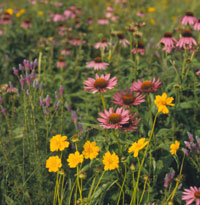 Purple coneflower and coreopsis offer a colorful contrast in any wildflower garden.
Purple coneflower and coreopsis offer a colorful contrast in any wildflower garden.
Birds love natural gardens because they can find all they need to survive in them. Seed heads of perennials and ornamental grasses provide food. Shrubs, trees, and some perennials offer shelter and nesting places. A birdbath contains water for drinking and bathing. You, meanwhile, gain the benefit of natural pest control because many birds eat hundreds of insects daily.
When you plan a natural wildlife garden, include a diverse selection of plants -- trees, shrubs, grasses, perennials, and annuals that reseed. Birds and other wildlife won't care if you have the latest cultivars; in fact, they prefer species and older varieties. Look for plants indigenous to your area, because they will look the most natural in it.
Learn how to attract hummingbirds to your garden.
continue reading below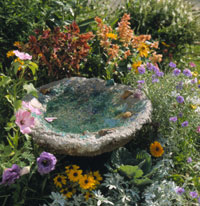 Surround your built-in birdbathwith bird-friendly plants.
Surround your built-in birdbathwith bird-friendly plants.
This special handmade birdbath belongs nestled in a flower bed where admirers will never know that it was so easy to make. You don't need a fancy mold to fashion the 18- to 20-inch basin. You can even use a cardboard box instead of the ground, as long as the box is at least 4 inches wider than the basin's width. Fill it 10 inches deep with soil; then scoop a basin shape in the soil.
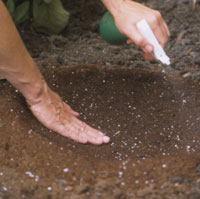 Step 1.
Step 1.
1. Dig and shape a hole in the ground (or in a cardboard box filled with 10 inches of soil) as a mold. Sprinkle the shape with water and pack down the soil firmly. Tamp a flat area in the center so the finished basin will sit securely on a flat surface.
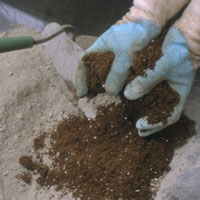 Step 2.
Step 2.
2. Wear protective gear. Combine 3 gallons of premixed concrete with 2 to 3 cups of peat moss in a wheelbarrow. Add about 2 gallons of water and quickly mix with a hoe to make a stiff batter. If it is too thin, add more concrete; if too thick to hold together, add water.
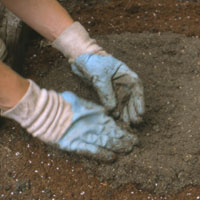 Step 3.
Step 3.
3. Work quickly, concrete starts to set in minutes. Shovel the wet mix into the mold. Scoop concrete from the center of the basin to the outside rim. Pat it into place, conforming it to the shape of the basin. Pat smooth. Spritz with water to keep concrete moist.
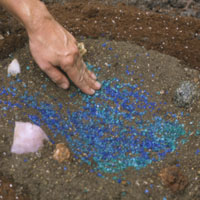 Step 4.
Step 4.
4. Decorate the basin by sprinkling crushed, recycled glass on the wet mix; press gently into place. You also can use other decorative pieces such as stones. Cover the basin with a plastic sheet; let cure for 3 to 7 days. Uncover; let age for 1 month before filling with water.
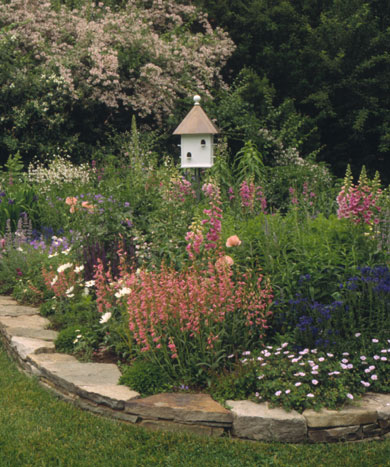 Attract butterflies by planting afew perennials and shrubsfor their larval needs andnectar preferences.
Attract butterflies by planting afew perennials and shrubsfor their larval needs andnectar preferences.
Butterflies need the warmth of the sun and appreciate a flat stone or two for basking. You will see them gather in groups if you provide a shallow puddle where they can drink. Protect them from strong winds with a garden near a few shrubs or trees that act as a windbreak.
You can incorporate butterfly plants into an existing bed or border or plant a separate garden. To a butterfly, fragrance is not as important as color, although it does play a role. The eyes of a butterfly perceive shades of yellow, red, and blue to lavender. The best flowering plants for a butterfly garden are wild or species forms rather than hybrids, single-flowered instead of double-flowered, and tubular or flat-topped. Plant in large groups; individual spots of color are less attractive than a broad wash of hues. Groups of 10 or more of the same color work well.
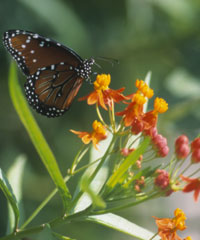 Butterfly weed is a favorite
nectar plant.
Butterfly weed is a favorite
nectar plant.
Beebalm and purple coneflower are two of the best plants for attracting butterflies. Plant groups of them around a weather fountain, and shelter the garden with a backdrop of evergreens.
Other butterfly-friendly plants include anise hyssop, black-eyed Susan, butterfly weed, coreopsis, dianthus, garden phlox, Queen Anne's lace, red valerian, thyme, and vervain.
Copyright © www.100flowers.win Botanic Garden All Rights Reserved